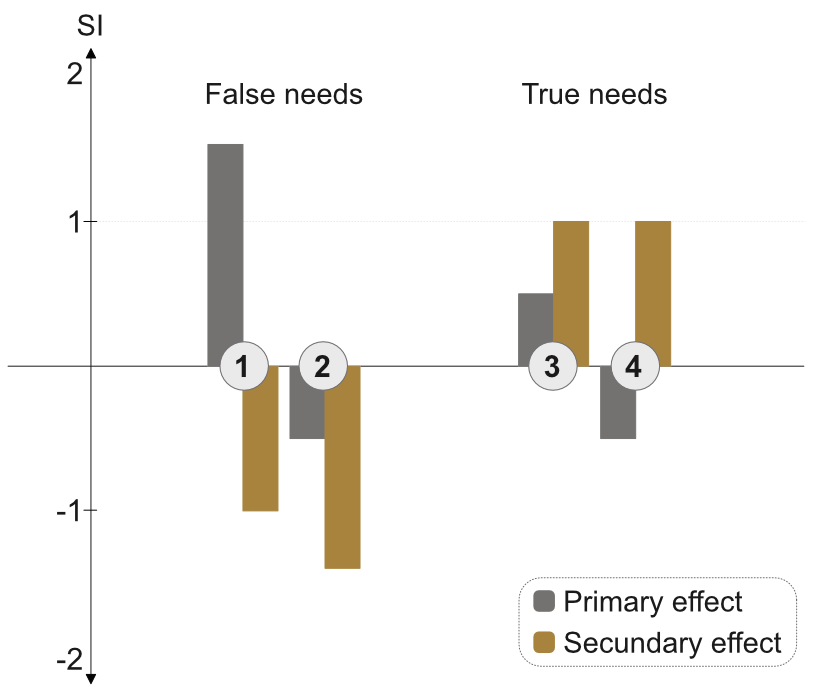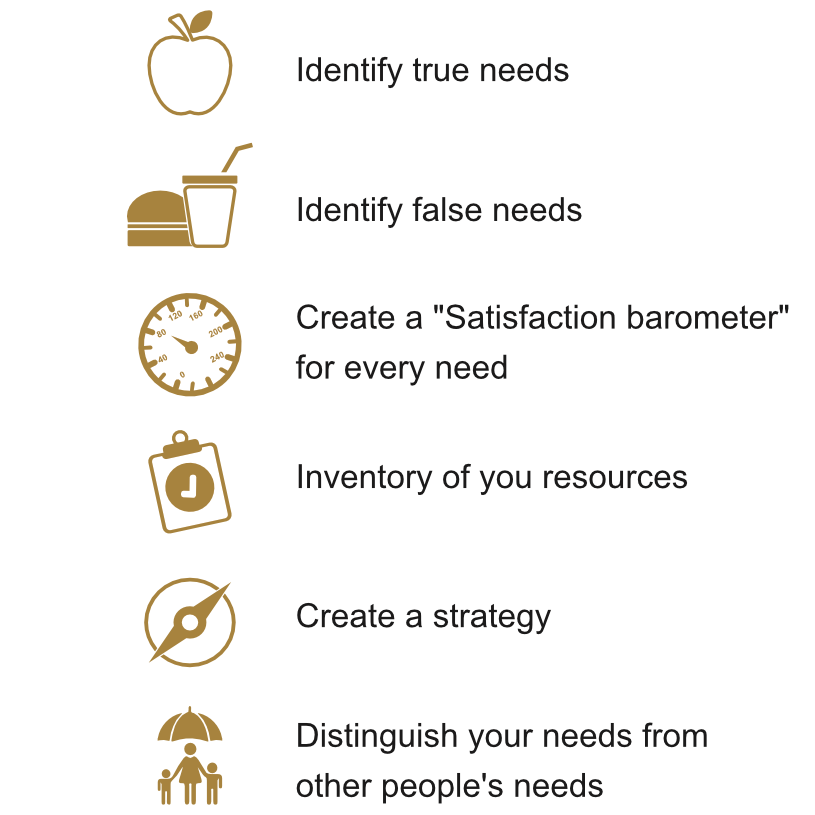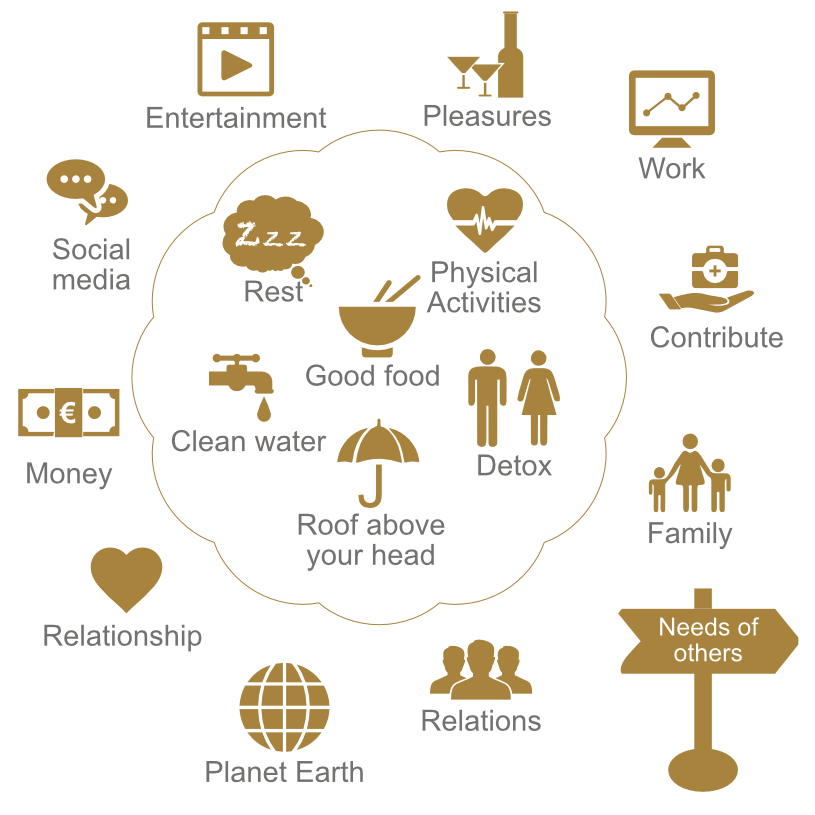Your whole life revolves around needs. From the moment you wake up in the morning to the moment your head hits the pillow again in the evening, your day is about experiencing and responding to needs of different kinds. It can be simple things like drinking when you are thirsty or eating when you are hungry; it can be more abstract and complex like working to earn money to buy food. It can also be finding outlets for the different sides of your personality, learning things or getting affirmation from people around you. Your needs are many and also change from moment to moment.
There are many different ways to look at and categorise needs. For the reasoning here, we only need to divide needs into two groups, true and false. Both true needs and false needs can be experienced as strong and irresistible. The difference between them is that false needs, despite their sometimes enormous attraction, can be eliminated. True needs can be ignored or postponed for a while but they are very difficult to eliminate. A false need might be that you feel you should always eat at the same time every day. A true need might be that you actually need to eat.
The four truths about needs
1 A sentient being experiences needs
2 Needs can be true or false
3 False needs can be eliminated
4 True needs cannot be eliminated
The consequences of meeting needs
Whether a need is true or false, the immediate feeling of satisfaction usually increases when you meet it. Your TSI rises. The converse also applies. If you do not succeed in meeting an experienced need, the feeling of dissatisfaction increases. Your TSI drops. This drives you to action in an attempt to reduce this feeling of dissatisfaction and increase the feeling of satisfaction instead. Thus, your behaviour is a consequence of feelings. The feelings can be of different kinds but remember that they are all variations of the same two themes: feeling satisfied or not feeling satisfied.
The three consequences
1 When a need is met, the feeling of satisfaction increases
2 When a need is not met, the feeling of dissatisfaction increases
3 Behaviour is a consequence of feelings
Mistaking needs
It isn’t always easy to distinguish between true needs and false needs. The strength of the experience doesn’t help much. However, it is that very experience which often decides how a need is ranked and how it is dealt with. The behaviour of an alcoholic is a very clear example. A particular type of false needs is what are often called high stimulants. They are false needs which not only lead to secondary dissatisfaction but also create a craving for more. Either more stimulus of the same kind or at least the same strength. We will look at the concept of high stimulation in the next chapter when we investigate the role of biological systems in this context. However, in brief, alcohol is the alcoholic’s high stimulant. It’s a false need which creates a craving for more and establishes an addiction or addictive behaviour.
Another phenomenon that makes it difficult for us sometimes is that we mistake other people’s feelings for our own. It’s one thing to feel empathy and to engage in someone else’s adversities or successes. It is quite another thing to identify with their feelings and treat them as our own. Being empathetic doesn’t mean feeling sorry for someone or feeling bad when the other person feels bad. We must distinguish between our own inner world and how other people express their feelings.
The three mistakes
1 Mistaking false needs for true needs
2 Mistaking high stimulants for needs
3 Mistaking other peoples’ feelings for our own
Recognising true and false needs
The easiest way to identify a false need is to look at the secondary emotional effects when the need has been met. The primary effect is usually positive, otherwise we probably would not have bothered to meet the need. However, the secondary effect is always negative when we meet a false need.
A false need often creates a strong desire to experience the same thing again. The memory of the strong primary effects outweigh the memory of the negative secondary effects. This is why we so easily forget how the positive experience becomes a negative one.
True needs and false needs are different for different people as well as being different for the same person on different occasions. We all have some true needs in common. Eating is a true need. Our behaviour concerning food is a good example of the different types of true needs and false needs and their consequences.
-
If you eat processed food, your primary experience is intense but the risk is that it is followed by a negative secondary effect. You may get a stomach-ache, a head-ache, feel tired or the processed, unnatural food can in the long term lead to mental and bodily ill health. Thus a false need with initial satisfaction is replaced by dissatisfaction.
-
Refusing food or other necessities over a long period to achieve a bodily or spiritual ideal would be a false need with negative primary and secondary effects.
-
If you eat healthy food cooked with fresh raw items without excessively refined ingredients, you probably meet a true need with both positive primary and secondary effects.
-
Physical activity is a true need which initially is often perceived negatively but after a while the feeling of satisfaction almost always increases.
The effects of meeting false needs:
- Primary satisfaction increases, secondary decreases
- Primary satisfaction decreases, secondary decreases
Compare this to true needs:
- Primary satisfaction increases, secondary increases
- Primary satisfaction decreases, secondary increases
If we consider the effects of fulfilling true needs and false needs really carefully, we see that even the initial experience of dissatisfaction in examples 2 and 4 contain some sense of satisfaction, although temporary. The urge to meet a need is itself driven by a sense of dissatisfaction.

Eliminating false needs
When you realize that it is more advantageous to do away with false needs so as to experience better well-being and a deeper sense of satisfaction, this leads to the question of how best to achieve this. How do you eliminate false needs? There is no clear answer to that question. For one person, it may be enough to realise that their behaviour is unhelpful and they decide to stop. For someone else, it requires a smart and long term strategy. The type of false needs, of course, also plays a big part but the main thing is how the need affects you. For me, it has been very much about paying attention to the negative consequences of fulfilling a false need and how much better I feel when I do not. I have been able to recall the memory of that feeling when I have felt that false need again.
Dare to be pleased with less. It is that simple. Dare to be pleased with less. Realise that actually you have it good. You don’t have to rush on to the next goal or next reward.
The investigative question
Because emotions and feelings control our behaviour, the smartest way to change our behaviour is to change the emotions that drive it. Changing the “soil” for our feelings and subsequent behaviour is a long-term project and Rome was not built in a day. In the short term or when the feelings of false needs take hold of you, it might be a good idea to have some tools to try to influence those emerging feelings in a positive way. One of the best tools in these challenging situations, is the investigative question. Here are some examples:
Situation: You really fancy something to eat.
Question: Why do I want to eat now?
Situation: You feel you need to buy something that you do not really need.
Question: Am I perhaps satisfied with what I have already got?
Situation: You have worked hard and feel you deserve to treat yourself. Question: What am I really treating myself to? Future ill health? Premature death?
Situation: Fancy some coffee, tea, hot chocolate, sugar or some other stimulant.
Question: Do I really need this right now?
Situation: You feel that this moment is just a stepping stone to sometime in the future when things will be better.
Question: What makes you feel the experience of this present moment is less worthwhile than future moments? Isn’t life always life, both now and later? Is there really a difference between them?
Situation: You think about what you are going to do later instead of focusing on the task you are doing now.
Question: Will this help me to achieve the future I want?
Situation: You feel like eating or doing something in a certain situation, for example, in natural breaks when you are at work.
Question: Is this really a desire or is it just an association between desire and a situation?
Additional question: Is this really a need or am I just reliving an enjoyable memory?
Different ways to meet needs
To meet needs in a good way is an art. Sometimes it goes wrong. For example, when we are unable to meet a need with the correct action. Perhaps because we misunderstood the need or perhaps because we simply do not have the right resources to meet the need.
One example is eating something sweet or drinking a cup of coffee when in fact you are tired and need to sleep. This would be replacing one need with another. You can often postpone needs without any serious side effects. You can finish your work and eat later. However, ignoring needs is not usually a good idea. If you ignore a need, whether it’s true or false, your “reward” will be a lower TSI.
The same thing happens when you try to eliminate a true need. True needs must be met so that your TSI is not lowered in the long term. When a true need is met, the secondary result in your emotional life is always satisfaction. False needs can be eliminated without any long-term negative consequences. At that particular moment, it can feel really hard to eliminate a false need but the long term result is that your TSI rises.
In summary:
- Fulfilling a true need is the best strategy
- Eliminating a false need is a good idea
- Trying to eliminate a true need is difficult
- Postponed needs always find their way back
- Ignoring a need is always a bad idea
- Replacing needs never works in the long run
Basic methods for meeting a need
- Meet a need
- Eliminate a need
- Postpone a need
- Ignore a need
- Replace a need
Your map of needs
If you want a chance of raising your TSI and reach a deeper sense of satisfaction and contentment, you must first “know where you are” and understand your inner and outer circumstances. You need to list your needs, analyse how well you meet them and whether you have the resources to meet those needs which have not yet been properly met.
Start by identifying all your needs without judging them or yourself. Then divide them up into true needs and false needs. Put every need on a “satisfaction barometer”, that is to say, analyse how well you have managed to meet every need. If you haven’t met the need yet, check if you have the resources to do so or if you can get them. You can probably almost immediately meet many needs in a favourable way; others may require a strategy and a long-term effort.
Also keep in mind that there are not just your own needs on your map of needs. Children, pets, friends, parents, partner, employer, employee, the sports club and many others may have needs that they place on you. You also need to identify and manage their needs in one way or another.

In the same boat
How you meet your own needs affects everyone with whom you come into contact. Your actions affect their resources and strategies to meet their needs, which in turn means that everyone they come into contact with is affected by your actions. We are all in the same boat! When these people act to meet their own needs, their actions will affect you, to a greater or lesser extent.
Starting-point
Your starting-point on your map of needs is determined by your emotional status, which is governed by the needs you have and how well you have met them. If you replace your feelings with different types of false needs, the starting-point won’t be true. It’s hard to find your way with a map if you don’t know where you are to begin with!
Basic needs
A good way to get started with your map of needs is to start with the most fundamental needs and then build from there. What are the fundamental needs for a human being?
- Good food
- Clean water
- Detoxification*
- A roof over your head
- Good hygiene
- Physical activity
- Rest
- Social activity**
The above points are the basic needs we require for survival. Other needs, from a certain perspective, are optional. What is your nutritional intake? Do you eat the food best suited to you? How well does your digestive system work? Do you feel worried about paying your housing costs? Do you take care of your body?
Start with the map below and then add on all the other needs that you experience – both big and small.
*The body's cleansing mechanisms must work well.
**Possibly not a basic need for every adult person

Self-awareness
Having self-awareness in this context is as simple as having the ability to correctly identify your needs and your resources, as well as being able to realise when you lack the necessary resources. Self-awareness is something you develop with practice.
Resources and self-awareness
- Available resources
- Unavailable resources
- Match the right needs with the right resource
To prioritise
When you feel that multiple needs are competing, you need to prioritise. The list below is one way of doing this in a sustainable way, choosing correctly so that in the long run you get the best possible outcome. You may not always choose the point you really feel is right and you can’t work with just one point at a time. However, the list gives you a reminder of how different parts of your life are dependent on each other. Without good health, for example, it is difficult to realise goals and ambitions.
The five building blocks for prioritising
- Inner peace and harmony
- Physical health
- Goals and ambitions
- Family and friends
- Work and career
That was a lot about needs but what are needs really all about? Let’s find out.